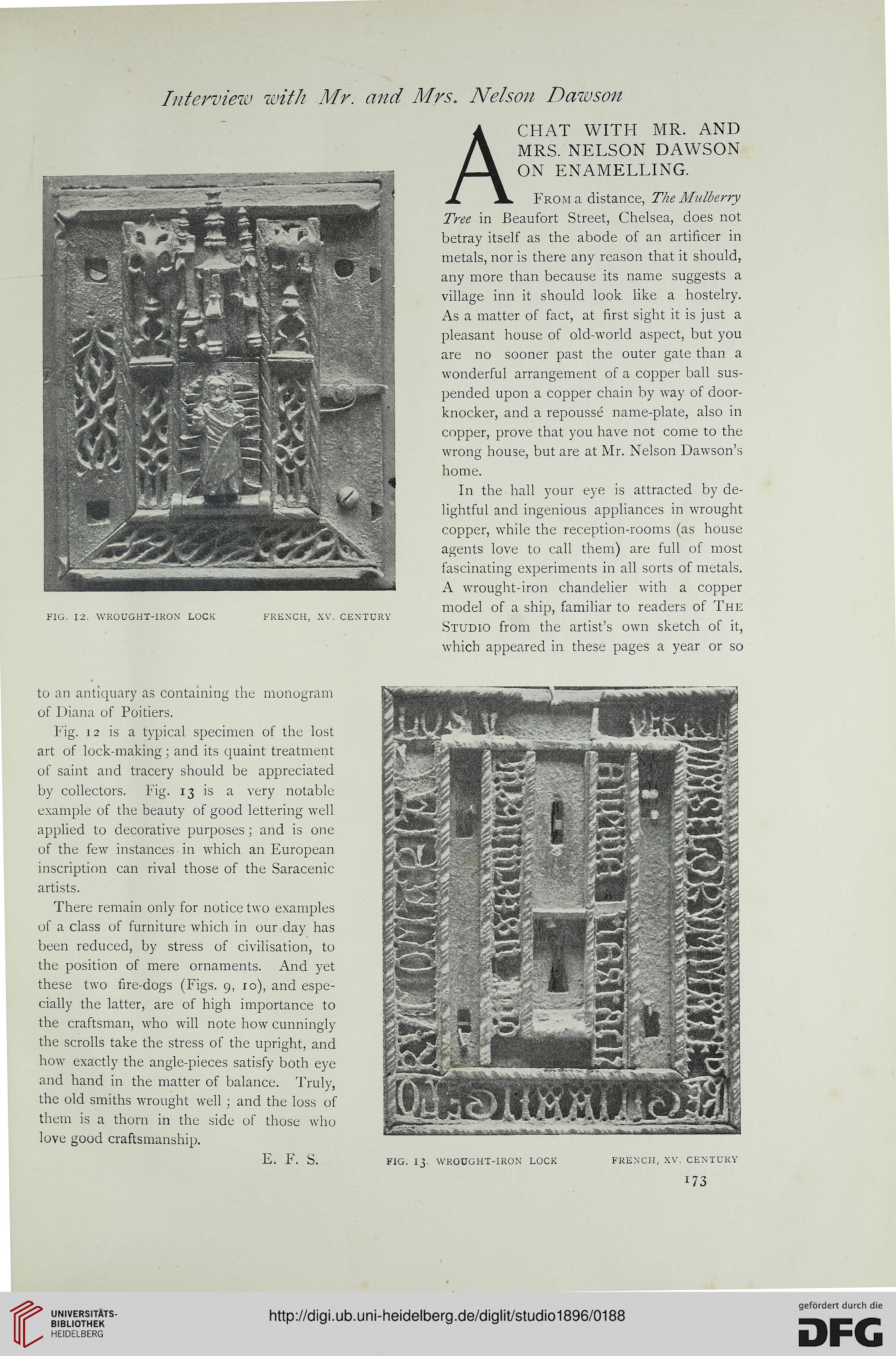Interview with Mr. and Mrs. Nelson Dawson
FIG. 12. WROUGHT-IRON LOCK FRENCH. XV. CENTURY
CHAT WITH MR. AND
MRS. NELSON DAWSON
ON ENAMELLING.
From a distance, The Mulberry
Tree in Beaufort Street, Chelsea, does not
betray itself as the abode of an artificer in
metals, nor is there any reason that it should,
any more than because its name suggests a
village inn it should look like a hostelry.
As a matter of fact, at first sight it is just a
pleasant house of old-world aspect, but you
are no sooner past the outer gate than a
wonderful arrangement of a copper ball sus-
pended upon a copper chain by way of door-
knocker, and a repousse name-plate, also in
copper, prove that you have not come to the
wrong house, but are at Mr. Nelson Dawson's
home.
In the hall your eye is attracted by de-
lightful and ingenious appliances in wrought
copper, while the reception-rooms (as house
agents love to call them) are full of most
fascinating experiments in all sorts of metals.
A wrought-iron chandelier with a copper
model of a ship, familiar to readers of The
Studio from the artist's own sketch of it,
which appeared in these pages a year or so
to an antiquary as containing the monogram
of Diana of Poitiers.
Fig. 12 is a typical specimen of the lost
art of lock-making; and its quaint treatment
of saint and tracery should be appreciated
by collectors. Fig. 13 is a very notable
example of the beauty of good lettering well
applied to decorative purposes ; and is one
of the few instances in which an European
inscription can rival those of the Saracenic
artists.
There remain only for notice two examples
of a class of furniture which in our day has
been reduced, by stress of civilisation, to
the position of mere ornaments. And yet
these two fire-dogs (Figs. 9, 10), and espe-
cially the latter, are of high importance to
the craftsman, who will note how cunningly
the scrolls take the stress of the upright, and
how exactly the angle-pieces satisfy both eye
and hand in the matter of balance. Truly,
the old smiths wrought well ; and the loss of
them is a thorn in the side of those who
love good craftsmanship.
E. F. S. FIG. 13. WROUGHT-IRON LOCK FRENCH, XV. CENTURY
173
FIG. 12. WROUGHT-IRON LOCK FRENCH. XV. CENTURY
CHAT WITH MR. AND
MRS. NELSON DAWSON
ON ENAMELLING.
From a distance, The Mulberry
Tree in Beaufort Street, Chelsea, does not
betray itself as the abode of an artificer in
metals, nor is there any reason that it should,
any more than because its name suggests a
village inn it should look like a hostelry.
As a matter of fact, at first sight it is just a
pleasant house of old-world aspect, but you
are no sooner past the outer gate than a
wonderful arrangement of a copper ball sus-
pended upon a copper chain by way of door-
knocker, and a repousse name-plate, also in
copper, prove that you have not come to the
wrong house, but are at Mr. Nelson Dawson's
home.
In the hall your eye is attracted by de-
lightful and ingenious appliances in wrought
copper, while the reception-rooms (as house
agents love to call them) are full of most
fascinating experiments in all sorts of metals.
A wrought-iron chandelier with a copper
model of a ship, familiar to readers of The
Studio from the artist's own sketch of it,
which appeared in these pages a year or so
to an antiquary as containing the monogram
of Diana of Poitiers.
Fig. 12 is a typical specimen of the lost
art of lock-making; and its quaint treatment
of saint and tracery should be appreciated
by collectors. Fig. 13 is a very notable
example of the beauty of good lettering well
applied to decorative purposes ; and is one
of the few instances in which an European
inscription can rival those of the Saracenic
artists.
There remain only for notice two examples
of a class of furniture which in our day has
been reduced, by stress of civilisation, to
the position of mere ornaments. And yet
these two fire-dogs (Figs. 9, 10), and espe-
cially the latter, are of high importance to
the craftsman, who will note how cunningly
the scrolls take the stress of the upright, and
how exactly the angle-pieces satisfy both eye
and hand in the matter of balance. Truly,
the old smiths wrought well ; and the loss of
them is a thorn in the side of those who
love good craftsmanship.
E. F. S. FIG. 13. WROUGHT-IRON LOCK FRENCH, XV. CENTURY
173





